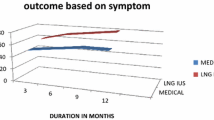Abstract
Levonorgestrel-releasing intrauterine devices have been used for contraception and treatment of heavy menstrual bleeding. There is only limited data about the effect of this on isthmocele. Here, we aimed to evaluate the effect of levonorgestrel-releasing intrauterine devices in a larger study population with a longer follow-up as compared to the literature on symptomatic patients with isthmocele. A total of 29 patients with symptomatic isthmocele and inserted levonorgestrel-releasing device were included in this prospective study. All patients were included at January 2020 and followed for 18 months. Sociodemographic findings, laboratory parameters, premenstrual spotting, postmenstrual spotting, menorrhagia, dysmenorrhea, and pelvic pain related to isthmocele were recorded. In sonography, width, length, area of isthmocele, and residual myometrial thickness were determined. The frequency of symptoms during follow-up was compared between visits and also compared between groups according to residual myometrial thickness. Premenstrual spotting and pelvic pain were significantly reduced at 6th months (48.3 to 10.3%, p = 0.007 and 34.5 to 10.3%, p = 0.039, respectively) and no significant change was detected until the end of follow-up period. Postmenstrual spotting reduced at 6th months (96.6 to 34.5%, p < 0.001) and also significant change was detected between 6 and 12th months (34.5% vs 13.8%, p = 0.031). Menorrhagia and dysmenorrhea disappeared at 12th months. No association was found between residual myometrial thickness and the frequency of symptoms for each follow-up. Levonorgestrel-releasing intrauterine devices are useful and reliable therapeutic tools for symptomatic isthmocele patients who do not desire fertility, regardless of residual myometrial thickness.
Similar content being viewed by others
Data Availability
Data can be shared under reasonable request.
Code Availability
Not applicale.
References
Florio P, Filippeschi M, Moncini I, Marra E, Franchini M, Gubbini G. Hysteroscopic treatment of the cesarean-induced isthmocele in restoring in fertility. Curr Opin Obstet Gynecol. 2012;24(3):180–6.
Bij de Vaate AJ, Brolmann HA, van der Voet LF, van der Slikke JW, Veersema S, Huirne JA. Ultrasound evaluation of the cesarean scar: relation between a niche and postmenstrual spotting. Ultrasound Obstet Gynecol. 2011;37:93–9.
Tower AM, Frishman GN. Cesarean scar defects: an underrecognized cause of abnormal uterine bleeding and other gynecologic complications. J MinimInvasive Gynecol. 2013;20(5):562–72.
Chen Y, Tsai C, Lan K, Ou Y. Preliminary report on the use of a levonorgestrel intrauterine system for the treatment of intermenstrual bleeding due to previous cesarean delivery scar defect. J Obstet Gynaecol Res. 2019;45(10):2015–20.
Florio P, Gubbini G, Marra E, Dores D, Nascetti D, Bruni L, et al. A retrospective case control study comparing hysteroscopic resection versus hormonal modulation in treating menstrual disorders due to isthmocele. Gynecol Endocrinol. 2011;27(6):434–8. https://doi.org/10.3109/09513590.2010.4954.
VikharevaOsser O, Jokubkiene L, Valentin L. High prevalence of defects in Cesarean section scars at transvaginal ultrasound examination. Ultrasound Obstet Gynecol. 2009;34:90–7.
Kremer TG, Ghiorzi IB, Dibi RP. Isthmocele: an overview of diagnosis and treatment. Rev Assoc Med Bras. 2019;65(5):714–21.
Marotta ML, Donnez J, Squifflet J, Jadoul P, Darii N, Donnez O. Laparoscopic repair of post-cesarean section uterine scar defects diagnosed in nonpregnant women. J Minim Invasive Gynecol. 2013;20(3):386–91.
Bujold E, Jastrow N, Simoneau J, Brunet S, Gauthier R. Prediction of complete uterine rupture by sonographic evaluation of the lower uterine segment. Am J Obstet Gynecol. 2009;201:320.
Nelson AL. Levonorgestrel-releasing intrauterine system (LNG-IUS12) for prevention of pregnancy for up to five years. Expert Rev Clin Pharmacol. 2017;10(8):833–42.
ZhangX YangM, WangQ ChenJ, DingJ HuaK. Prospective evaluation of five methods used to treat cesarean scar defects. Int J Gynecol Obstet. 2016;134(3):336–9.
https://www.mirenahcp.com/about-mirena/who-is-right-for-mirena.
Setubal A, Alves J, Osório F, Guerra A, Fernandes R, Albornoz J, et al. Treatment for uterine isthmocele, a pouchlike defect at the site of a cesarean section scar. JMinimInvasive Gynecol. 2018;25(1):38–46.
He X, Yan L, He C, Zhu C, Mol BW, Zhang J, et al. The effect of a hysteroscopic niche resection compared with LNG-IUD on postmenstrual spotting in women with a symptomatic niche in the uterine cesarean scar:a prospective cohort study. 2021. Eur J Obstet Gynecol Reprod Biol. 2021;265:66–73.
Gubbini G, Centini G, Nascetti D, Marra E, Moncini I, Bruni L, et al. Surgical hysteroscopic treatment of cesarean induced isthmocele in restoring fertility: prospective study. J Minim Invasive Gynecol. 2011;18:234–7.
Tulandi T, Cohen A. Emerging manifestations of cesarean scar defect in reproductive-aged women. J Minim Invasive Gynecol. 2016;23(6):893–902.
van der Voet LF, Bij de Vaate AM, Veersema S, Brölmann HA, Huirne JA. Long-term280 complications of caesarean section. The niche in the scar: a prospective cohort study on281niche prevalence and its relation to abnormal uterine bleeding. BJOG. 2014;121:236–44.
Vervoort A, van der Voet LF, Hehenkamp W, Thurkow AL, van Kesteren P, Quartero H, et al. Hysteroscopic resection of a uterine caesarean scar defect (niche) in women with postmenstrual spotting: a randomised controlled trial. BJOG. 2018;125(3):326–34.
Kulshrestha V, Agarwal N, Kachhawa G. Post-caesarean niche (isthmocele) in uterine scar: an update. J Obstet Gynaecol India. 2020;70:440–6.
Thurmond AS, Harvey WJ, Smith SA. Cesarean section scar as a cause of abnormal vaginal bleeding: diagnosis by sonohysterography. JUltrasound Med. 1999;18(1):13–6.
Zgliczynska M, Kocaj K, Szymusik I, Dutsch-Wicherek MM, Ciebiera M, Kosinska-Kaczynska K. Levonorgestrel-releasing intrauterine system as a contraceptive method in nulliparous women: a systematic review. J Clin Med. 2020;9(7):2101.
Heikinheimo O, Gemzell-Danielsson K. Emerging indications for the levonorgestrel-releasing intrauterine system (LNG-IUS). Acta Obstet Gynecol Scand. 2011;91(1):3–9.
Donnez O. Cesarean scar defects: management of an iatrogenic pathology whose prevalence has dramatically increased. Fertil Steril. 2020;113(4):704–16.
Author information
Authors and Affiliations
Corresponding author
Ethics declarations
Ethics Approval
It was approved by the institutional review board and ethics committee (approval number: 11.12.2019/159).
Consent to Participate
All the participants signed a written informed consent to participate to the study.
Consent for Publication
All the participants signed a written informed consent for publication regarding their data.
Conflict of Interest
The authors declare no competing interests.
Rights and permissions
About this article
Cite this article
Gencer, F.K., Dincgez, B. & Yuksel, S. Levonorgestrel-Releasing Intrauterine Device Use Can Be a Treatment Option in Symptomatic Patients with Isthmocele. Reprod. Sci. 29, 2977–2982 (2022). https://doi.org/10.1007/s43032-022-00976-1
Received:
Accepted:
Published:
Issue Date:
DOI: https://doi.org/10.1007/s43032-022-00976-1



